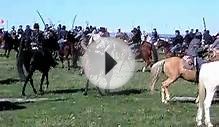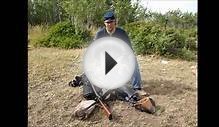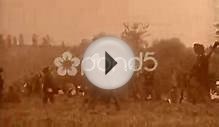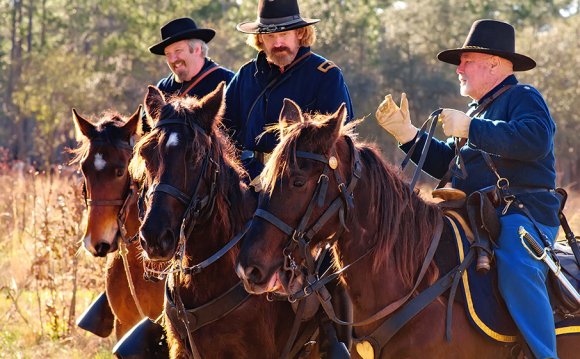
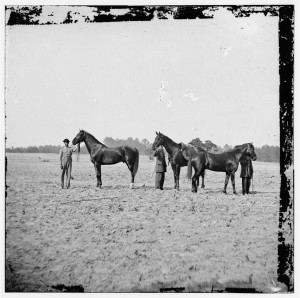 This past spring, I was asked to write a short article (about 1000 words) on horses in the Civil War for The History Channel Magazine. I had less than a week to do so, but I got it done. It was supposed to appear in the January/February 2013 issue, but there has been a regime change at the magazine, and the new editorial staff decided not to use any of the articles that it had in the hopper, including my article. Lest it go to waste, I’ve decided to run it here. Enjoy.
This past spring, I was asked to write a short article (about 1000 words) on horses in the Civil War for The History Channel Magazine. I had less than a week to do so, but I got it done. It was supposed to appear in the January/February 2013 issue, but there has been a regime change at the magazine, and the new editorial staff decided not to use any of the articles that it had in the hopper, including my article. Lest it go to waste, I’ve decided to run it here. Enjoy.
The photo is of U.S. Grant’s three horses, Egypt (on the left), Cincinnati (in the center) and Jeff Davis (on the right), taken at Cold Harbor, Virginia in the spring of 1864.
THE LOYAL STEEDS: HORSES IN THE CIVIL WAR
By: Eric J. Wittenberg
During the era of the Civil War, 1861-1865, there were no internal combustion engines fueled by gasoline, so there were only three ways to transport men, equipment and supplies: by boat, by train, or by horse. Horses were the primary means for logistics. Horses were used by artillery, by cavalry, by infantry, and by teamsters to move men and equipment. When the Civil War broke out in the spring of 1861, there were approximately 3.4 million horses in the Northern states, and 1.7 million in the Confederate states. The border states of Missouri and Kentucky had an additional 800, 000 horses. During the Civil War, the Union used over 825, 000 horses for the purposes described above.
More than 1, 000, 000 horses and mules were killed during the Civil War. In the early days of the conflict, more horses than men were killed. Just at the July 1863 Battle of Gettysburg alone, the number of horses killed was about 1, 500—881 horses and mules for the Union, and 619 for the Confederacy. The toll taken on these loyal animals—upon which both sides relied heavily—was staggering, and is all too often overlooked.
Napoleon once wrote, quite correctly, that “an army moves on its stomach, ” meaning that logistics are the key to the success of an army in the field. The great Union general, Maj. Gen. William T. Sherman, understood this well, prompting him to write, “Every opportunity at a halt during a march should be taken advantage of to cut grass, wheat, or oats and extraordinary care be taken of the horses upon which everything depends.”
The artillery relied heavily on horses, which were the primary means of moving heavy cannons from place to place. In so-called “mounted artillery”, which typically served with the infantry, the men who served those cannons either walked or rode on the caissons or limber chests, while horses and mules pulled the guns. The horses involved were usually big draft animals that were capable of bearing heavy weights. Maj. Gen. John Gibbon, who wrote the standard treatise for artillerists in the Civil War, The Artillerist’s Manual, described the ideal artillery horse:
The horse for artillery service should be from fifteen to sixteen hands high … should stand erect on his legs, be strongly built, but free in his movements; his shoulders should be large enough to give support to the collar but not too heavy; his body full, but not too long; the sides well rounded; the limbs solid with rather strong shanks, and the feet in good condition. To these qualities he should unite, as much as possible, the qualities of the saddle horse; should trot and gallop easily, have even gaits and not be skittish.
When artillery served with cavalry, it was called horse artillery, and each man had his own horse, so that the artillery could keep pace with fast-moving cavalry.
Draft animals also served to move the army’s vast wagon trains of supplies. Typically six horses or mules drew each wagon, which could be full of supplies, personal baggage, or medical supplies. Draft animals and mules also pulled ambulances, which carried wounded men from battlefields. As just one example, after the Battle of Gettysburg, a seventeen-mile long wagon train of wounded men was needed to remove the most seriously injured Confederate soldiers from the battlefield. But for the horses and mules that made it possible, these men probably would not have made it back to safety.
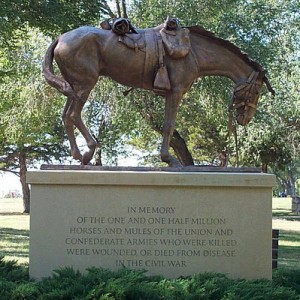 The most obvious use of horses in the Civil War was to carry cavalry. Cavalry featured mounted men who used their horses to move from place to place, and who could fight either mounted or dismounted. A cavalryman and his horse became a team, and men often developed deep bonds with their horses. Those horses often faced stern tasks.
The most obvious use of horses in the Civil War was to carry cavalry. Cavalry featured mounted men who used their horses to move from place to place, and who could fight either mounted or dismounted. A cavalryman and his horse became a team, and men often developed deep bonds with their horses. Those horses often faced stern tasks.
Capt. George Baylor of the 12th Virginia Cavalry left this description of that close bond:
The cavalryman and his horse got very close to each other, not only physically, but also heart to heart. They ate together, slept together, marched, fought and often died together. While the rider slept, the horse cropped the grass around him and got as close up to his rider’s body as he could get. The loyal steed pushed the trooper’s head gently aside with his nose to get at the grass beneath it. By the thousands, men reposed in fields fast asleep from arduous campaigns with their horses quietly grazing beside them, and nary a cavalier was trod upon or injured by his steed.
They were so faithful and unfaltering. When the bugle sounded, they were always ready to respond, for they knew all the bugle calls. If it were saddle up, or the feed, or the water call, they were as ready to answer one as the other. And they were so noble and so brave in battle. They seemed to love the sound of the guns. The cavalryman might lie low on the neck of his horse as the missiles of death hissed about him. But the horse never flinched, except when struck.
Lo! As we should, we build monuments for our dead soldiers, for those we know, and for the unknown dead. So with the ultimate sacrifice of our lamented fallen honored upon their noble deaths, is it not also just that we recall their valiant steeds? What would you think of a monument some day, somewhere in Virginia, in honor of Lee’s noble horses?
Without the horse, there could be no cavalryman.
The lore of the Civil War is replete with famous horses. Confederate commander Gen. Robert E. Lee had his beloved Traveler. Lt. Gen. Thomas J. “Stonewall” Jackson had his Little Sorrel. Maj. Gen. Philip H. Sheridan, who made a legendary 22-mile dash from Winchester to the battlefield at Cedar Creek on October 19, 1864, rode his warhorse Rienzi. Lt. Gen. Ulysses S. Grant had his Cincinnati. Lt. Gen. Nathan Bedford Forrest had his King Philip, and Maj. Gen. George G. Meade, the victor at Gettysburg, had his Old Baldy. These famous mounts carried their masters into battle and into legend.
In some ways, the horses that suffered and died during the Civil War were more important than the men who rode them. The Union certainly could not have prevailed in the Civil War without the horses that it relied upon so heavily.
how often should aims be done how often does waste management bill why startup india how many system restore points are kept how technology impacts society whose system does tello use how many product placements in he's all that why management is important when product of inertia is zero how much technology changed over the time where does development occur who road map teaching where i'm from poem when manager says thanks how many device can use hbo max how business works startup who is mara where london is situated where is izzy from startup how much solution for tb skin test how much product to use skincare how much project manager earn in india why project management interview question whos london boy about why project based learning why development matters what system does the us use which entrepreneur had a significant impact how many manager does bts have why device manager can't open how product managers work with data scientists how much startup money for a small business how much start up loan can i get how to find development opportunities when product owner is not available what startup programs do i need how many hours does a district manager work why science is important how much business class emirates who owns defi solutions how many business days whose science whose knowledge pdf what design style is studio mcgee who solution definition which business should i startINTERESTING VIDEO
